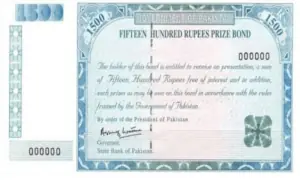SBP keeps policy rate unchanged at 21%
The State Bank of Pakistan has decided to keep the policy rate unchanged at 21 per cent, saying that it was necessary to bring inflation down to the medium-term target range of 5% to 7% by the end of FY25.
“The MPC noted that higher inflation outturns for April and May were broadly as anticipated,” said the monetary policy statement of the central bank on Monday.
Last week, the ruling alliance presented Rs14.46 trillion ($50.45 billion) worth of outlay with a budget deficit target of 6.54% (Rs7.57 trillion) of economic output in the fiscal year starting on July 1.
The committee also noted sequential ease in inflation expectations of both consumers and businesses from their recent peaks. Furthermore, it expects domestic demand to remain subdued amid tight monetary stance, domestic uncertainty, and continuing stress on external accounts.
Against this backdrop, the MPC viewed inflation to have peaked at 38% in May 2023, and barring any unforeseen developments, expects it to start falling from June onwards.
Multiple developments since the last meeting were reviewed. First, the provisional national accounts estimates showed real GDP growth to have decelerated considerably during FY23.
Secondly, the current account balance recorded back-to-back surpluses in March and April 2023, which reduced some pressures on foreign exchange reserves. Third, the government unveiled the budget for FY24 on June 9, which “envisages a slightly contractionary fiscal stance against the revised estimates for FY23”.
The global commodity prices and financial conditions have eased recently and were expected to persist in the near term.
The MPC also took stock of the cumulative impact of the substantial monetary tightening undertaken so far, which is still unfolding. On balance, the MPC viewed the current monetary policy stance, with positive real interest rates on forward-looking basis, as appropriate to anchor inflation expectations and to bring down inflation towards the medium-term target - barring any unexpected domestic and external shocks.
But the MPC emphasised that the outlook was also contingent on “effectively addressing the prevailing domestic uncertainty and external vulnerabilities”.
Real sector
The provisional national accounts estimates showed that real GDP grew by 0.3% in FY23, from the revised FY22 growth of 6.1%.
“The major drag came from a significant contraction in value addition of industry due to several adverse domestic and external factors; while services sector grew at the slowest pace since the Covid-impacted FY20. The agriculture sector growth was lower than last year but better than post-flood expectations, as bumper sugarcane and wheat crops and robust growth in the livestock sector largely offset the flood-related damages to cotton and rice crops.”
The MPC also noted that the slowdown in economic activity was in line with the trends in high frequency indicators, especially double-digit declines in volumes of auto, POL and domestic cement sales, and contraction in large-scale manufacturing during the course of this fiscal year.
Such trends were expected to continue in the near term due to the accumulated impact of tight policies. On the other hand, in the absence of any unfavorable turn in weather conditions, the agriculture sector was expected to post an improved performance relative to the outgoing fiscal year.
External sector
The current account continues to respond to the demand-compression policies and regulatory mix, with the deficit during Jul-Apr FY23 dropping to $3.3 billion, less than one-fourth of last year’s deficit. The policy induced contraction in imports more than offset the drop in exports and remittances.
The MPC noted that the “narrowing of the current account deficit” has somewhat contained pressures on the foreign exchange reserves and the interbank exchange rate, which has broadly remained stable since the last MPC meeting.
But debt repayments amid lower fresh disbursements and weak investment inflows “continue to exert pressure” on the foreign exchange reserves. “Going forward, under the baseline assumptions of relatively favorable outlook for commodity prices and moderate domestic economic recovery next year, the MPC views that the current account deficit will broadly remain in check,” it said.
Fiscal sector
The fiscal position has improved in cumulative terms during Jul-Mar FY23, as the fiscal deficit reduced slightly to 3.6 per cent of GDP from 3.9 per cent last year, while the primary balance posted a surplus of 0.6 per cent of GDP this year against a deficit last year.
“Notwithstanding this cumulative improvement, there has been some deterioration in fiscal indicators in Q3, largely reflecting an increase in non-interest current expenditures, mainly subsidies, and a significant deceleration in the pace of overall tax revenue.”
Usual end year increase in developmental spending and further slowdown in revenue collection amidst substantial slowdown in domestic economic activity and contraction in imports, points to a further increase in the fiscal deficit in Q4, it added.
The revised estimates show fiscal deficit at 7.0% and primary deficit at 0.5% of GDP for FY23. The FY24 budget envisages the fiscal deficit at 6.5 per cent and a primary surplus of 0.4 per cent of GDP. The MPC noted that while the target for the overall fiscal deficit is not significantly different from the revised estimate for FY23, strictly adhering to it is imperative to contain inflationary and external account pressures.
Monetary and inflation outlook
The broad money (M2) growth decelerated in May 2023 compared to last year, largely due to a “substantial fall in private sector credit (PSC) and a contraction in net foreign assets” of the banking system.
The year over year growth in PSC decelerated to 7.1% in April 2023, substantially lower than 22.3% in April 2022. Sequentially, the PSC saw net retirement for the fourth consecutive month in April, mainly because of a substantial reduction in demand for working capital and consumer loans in the wake of subdued economic activity and high borrowing costs. While there was an uptick in credit for fixed investment in April, it was significantly lower in cumulative terms during Jul-Apr FY23 compared to the same period last year.
The national CPI inflation rose to 38% in May, pushing the average inflation to 29.2% during Jul-May FY23, compared to 11.3% in the same period last year.
Inflation remained broad-based, with food continuing to contribute more than half to the overall inflation in May.
“Importantly, core inflation maintained its upward trajectory, albeit at a slower pace, mainly indicating the second-round impact of higher food and energy prices and exchange rate depreciation amid still elevated inflation expectations. Within food, prices of few essential non-perishable items rose quite significantly in May, mainly due to domestic supply chain issues,” it said.
The MPC expected that reduced demand-side pressures and ease in inflation expectations, along with moderating global commodity prices and high base effect, would help bring inflation down from June 2023 onwards. “In this context, the MPC views that maintaining the current policy stance is necessary to bring inflation down to the medium-term target range of 5% to 7% by the end of FY25.”
For the latest news, follow us on Twitter @Aaj_Urdu. We are also on Facebook, Instagram and YouTube.




















Comments are closed on this story.